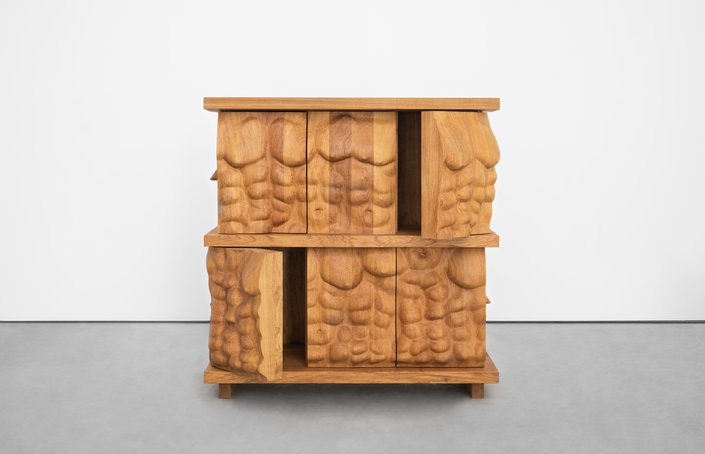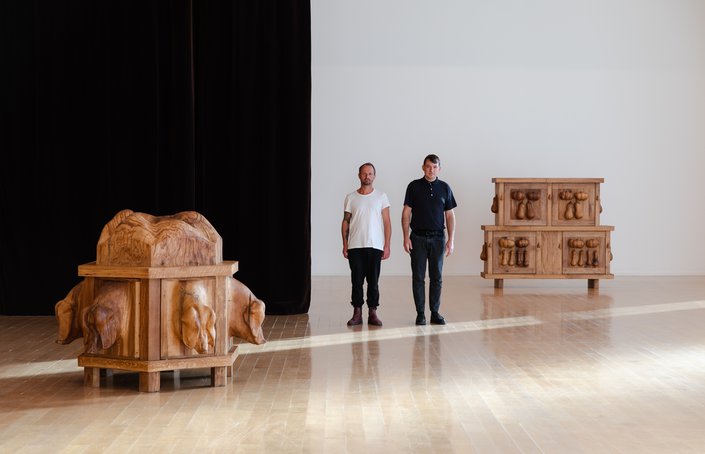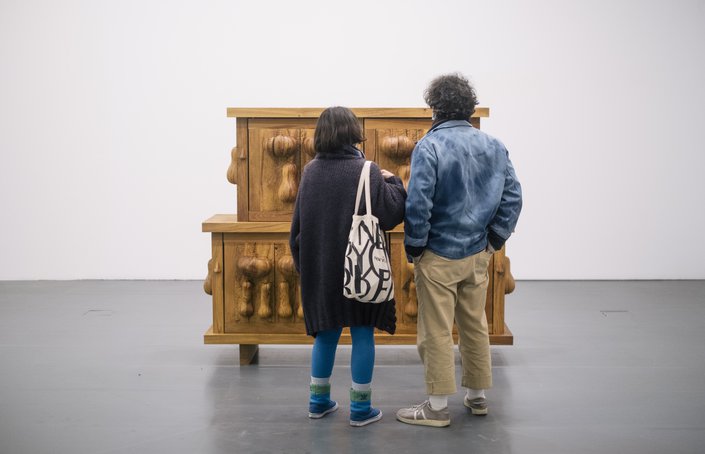The work of Daniel Dewar & Grégory Gicquel violates the pre-established codes behind sculpture and provides us with a new perspective on the physical relationship between materials and processes, including wood and stone sculptures, as in the case of The Nude and the Wood. This exhibition follows others by this Anglo-French duo in which the “nude” is represented in marble. All the marble pieces that can be seen in the Culturgest exhibition were extracted from Portuguese quarries.
Dewar and Gicquel’s work is permeated by a strong sense of manual labour, of the relationship between craftsmanship and traditional ways of making, in a display of erudition and joyous anarchy in which references of the past cast an ironic shadow over the present.
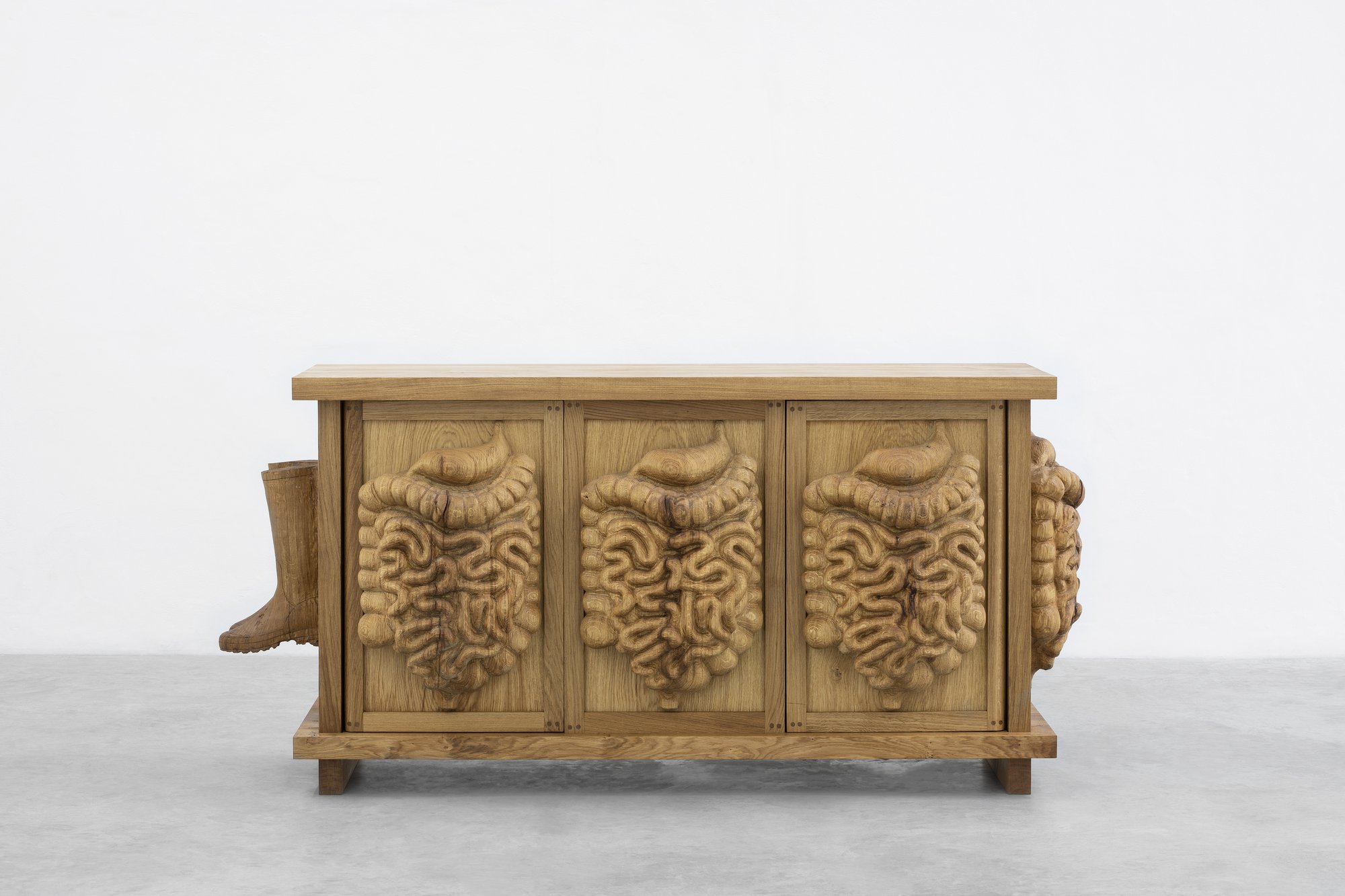
© Benjamin Baltus. Cortesia dos artistas e C L E A R I N G, New York/ Brussels; Jan Kaps, Cologne; e Loevenbruck, Paris.
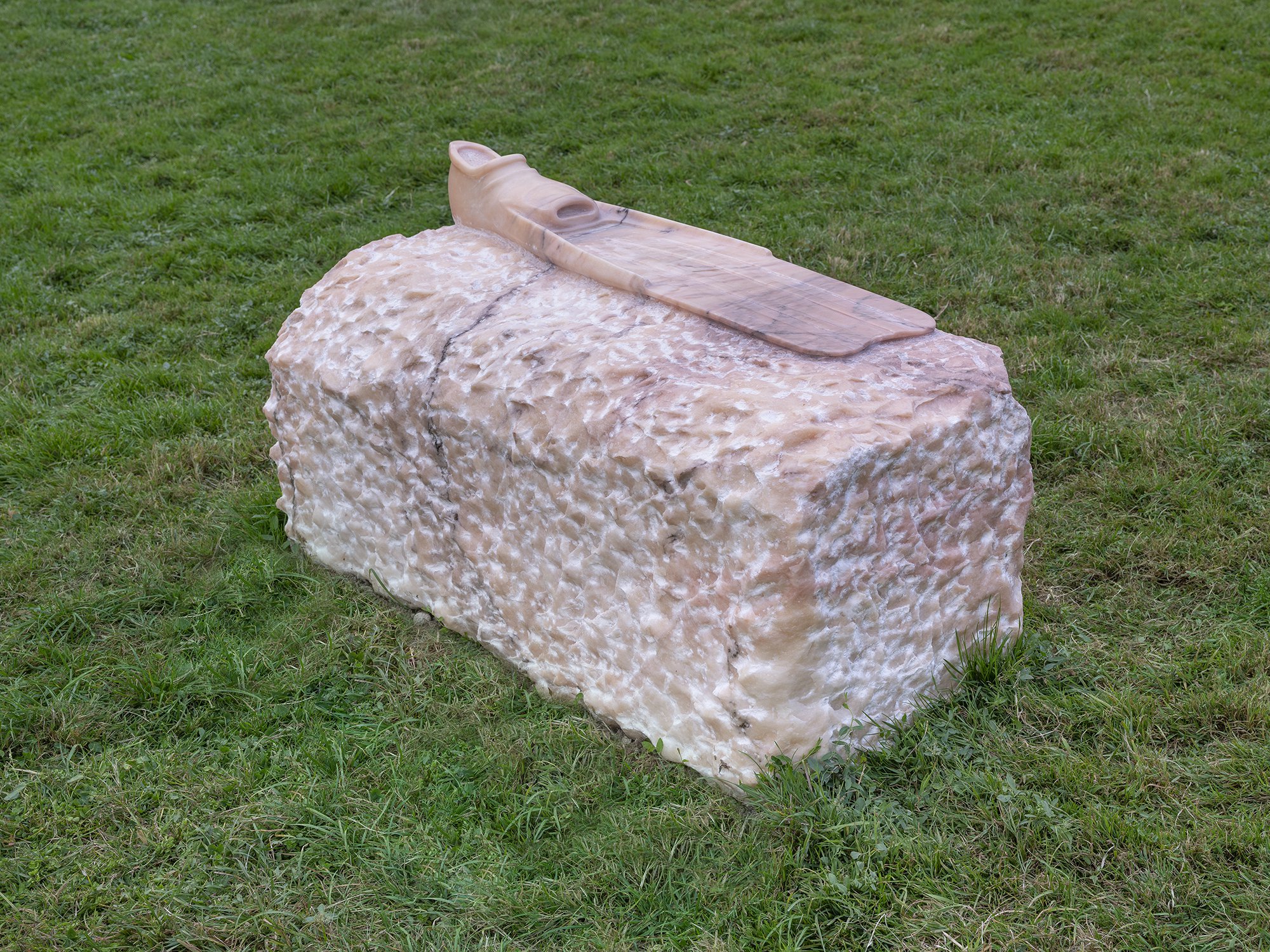
© Julien Gremaud. Cortesia dos artistas e C L E A R I N G, New York/ Brussels; Jan Kaps, Cologne; e Loevenbruck, Paris.
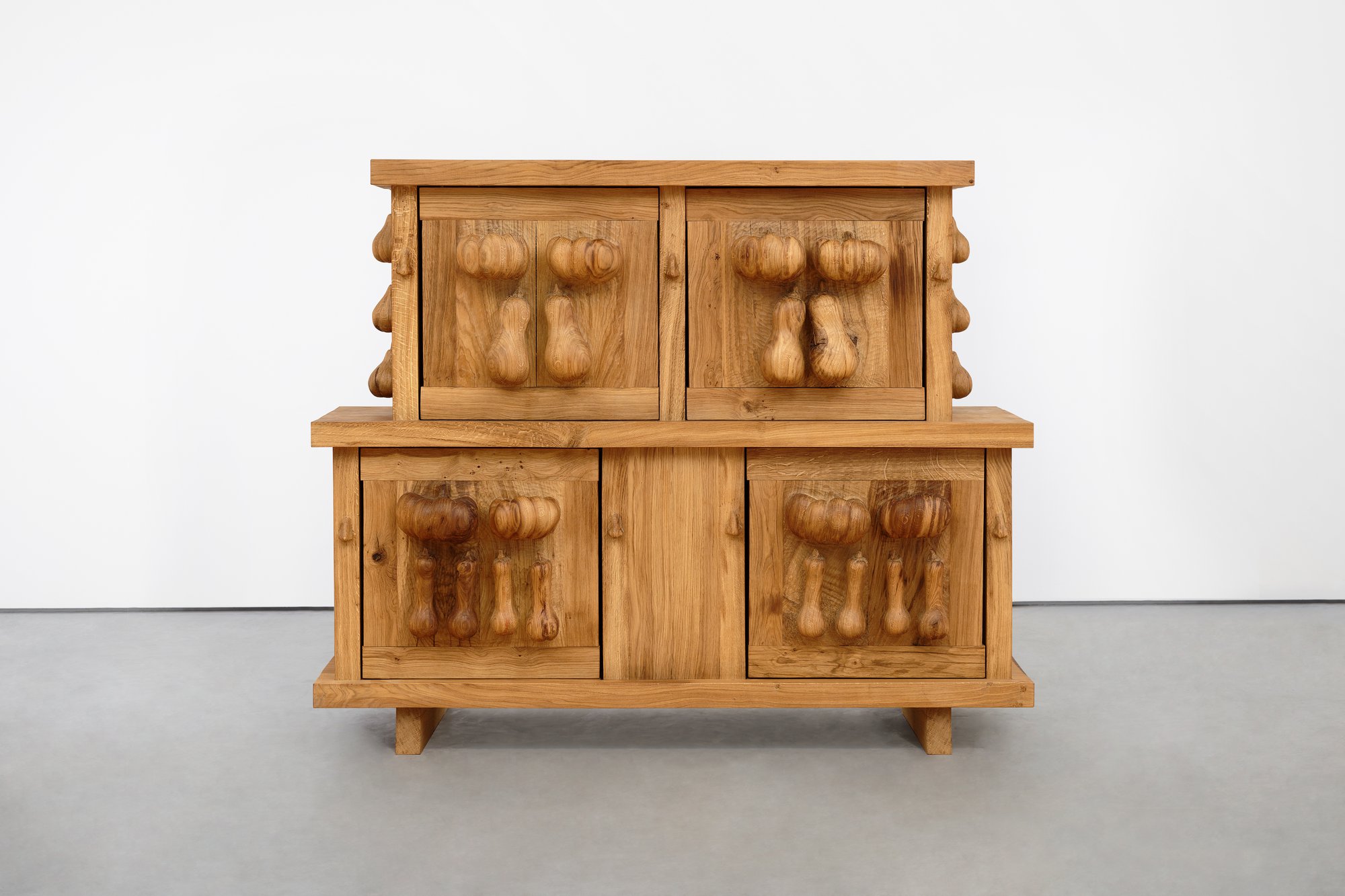
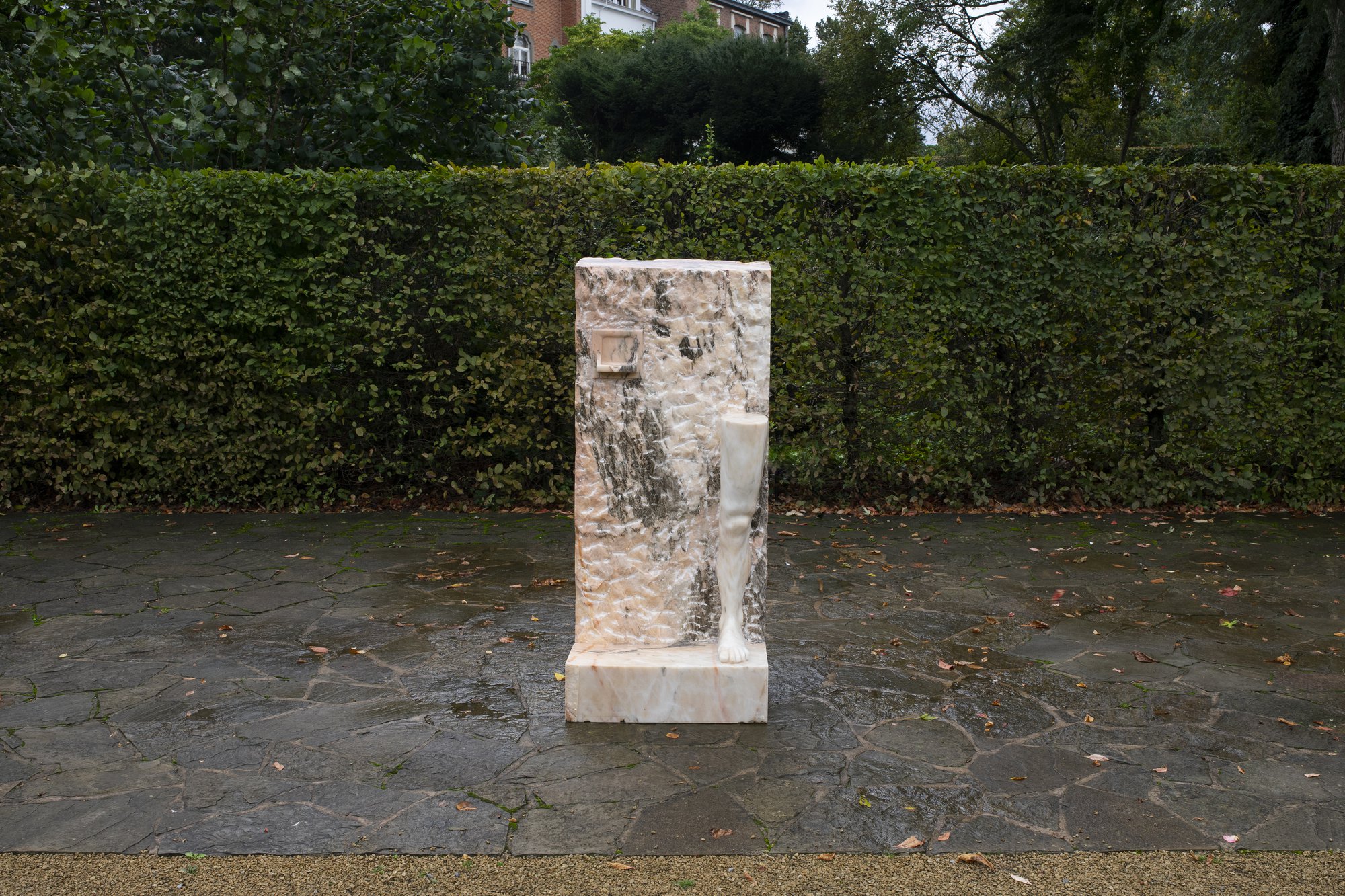
© Eden Krsmanovic. Cortesia dos artistas e C L E A R I N G, New York/ Brussels; Jan Kaps, Cologne; e Loevenbruck, Paris.
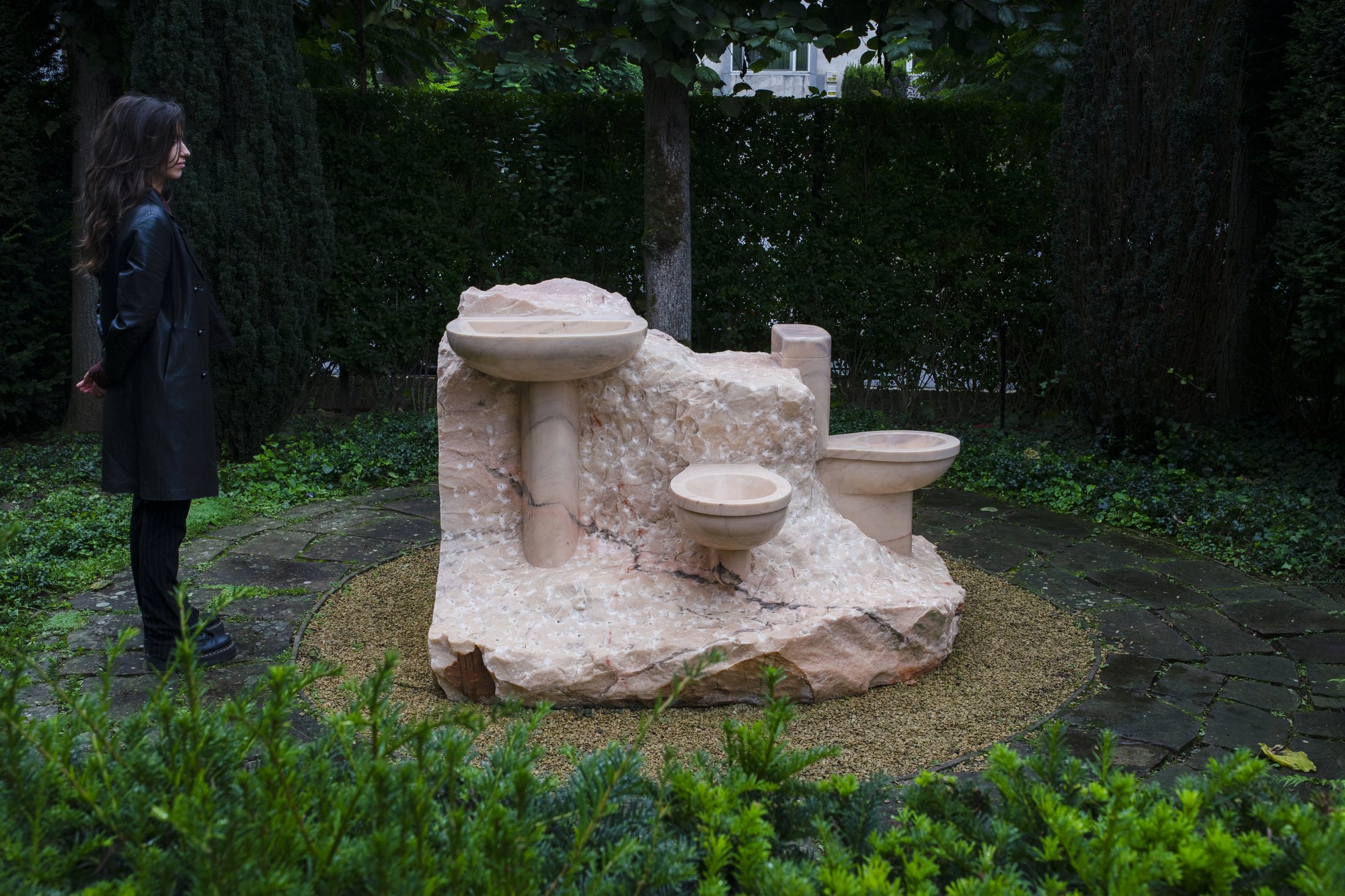
© Eden Krsmanovic. Cortesia dos artistas e C L E A R I N G, New York/ Brussels; Jan Kaps, Cologne; e Loevenbruck, Paris.
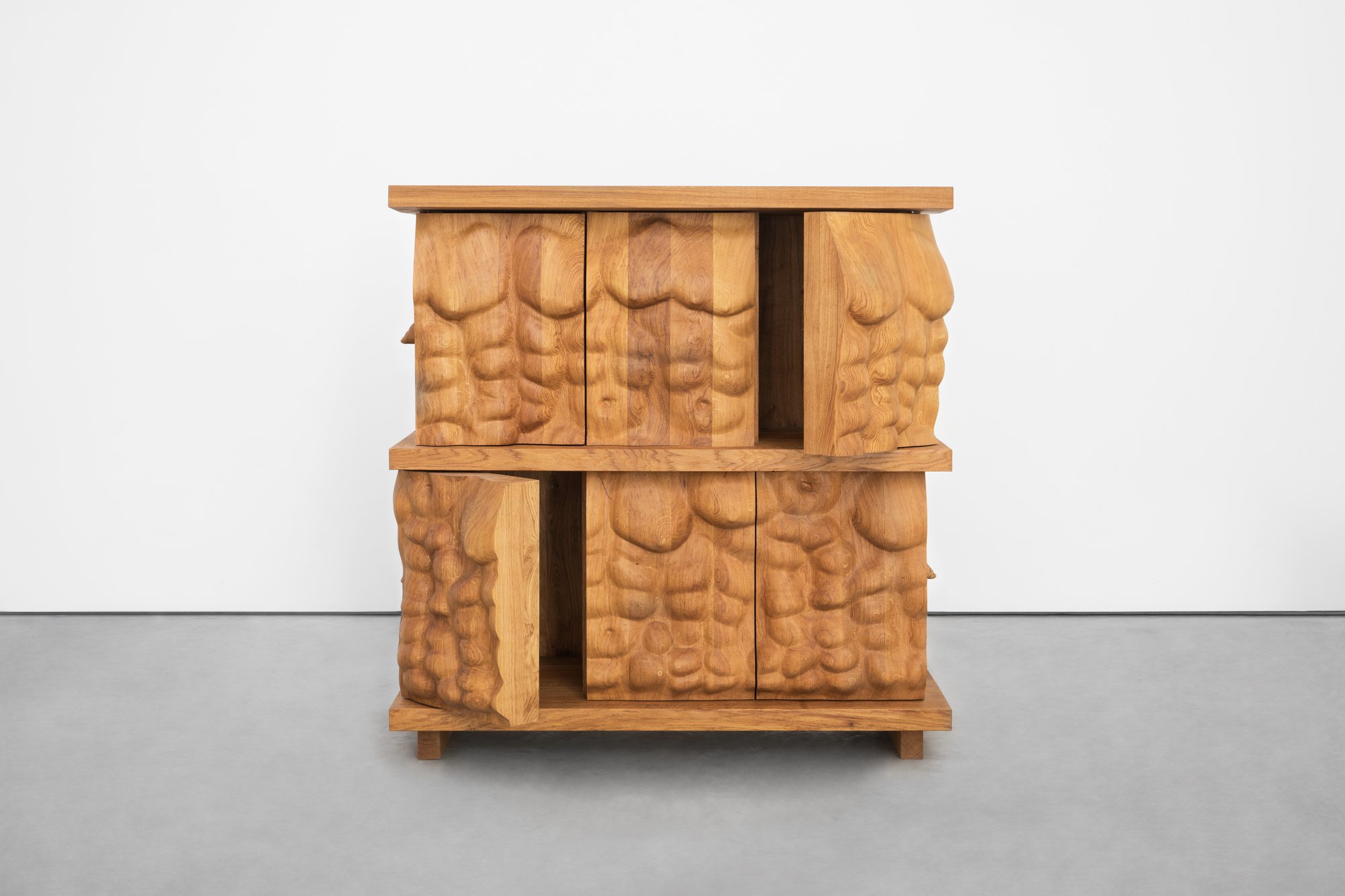
© Eden Krsmanovic. Cortesia dos artistas e C L E A R I N G, New York/ Brussels; Jan Kaps, Cologne; e Loevenbruck, Paris
Daniel Dewar and Grégory Gicquel, winners of the 2012 Marcel Duchamp Prize, will take over the Culturgest Gallery, in Lisbon, with The Nude and the Wood. This exhibition sparks a meeting between subject and materials, between trial and error, a process which is inherent to the manual work involved in making sculptures. The creation process, the time and methods employed acquire a role which is as important as the pieces themselves. In an interview to the Pompidou Centre, Dewar and Gicquel confirmed that in sculpture they have found a great source of autonomy: “We began making sculptures with our own hands because it was the most logic way to work, we couldn’t afford to pay people to make things for us. Over time, we realised that this method allowed us a sort of autonomy, and a great margin for improvisation. During the time it takes to make the piece, a field of possibilities opens up and we can change our minds even as the piece materializes before us. But this time for making is also a time of performance and establishing a physical relationship with a particular material. These aspects often become visible in the core of the piece, its manufacture retracing the various decisions and contradictions within, and the final result is a testimony of our gestures, which remain etched on the piece.”
In Portugal, they found the raw material for the series of sculptures that serve as a theme for “the nude”. The world-famous Estremoz anticline is the only geological area whose exploration has never been interrupted, and it has grown almost constantly over the past sixty years, being one of the main marble extraction hubs worldwide. Boasting a wide chromatic variety, this was where Daniel Dewar and Grégory Gicquel found the pink marble used in this exhibition’s pieces. We also visited this location in our marble route in search of the history of this ore, and where we found what is probably the deepest man-made quarry in the world.
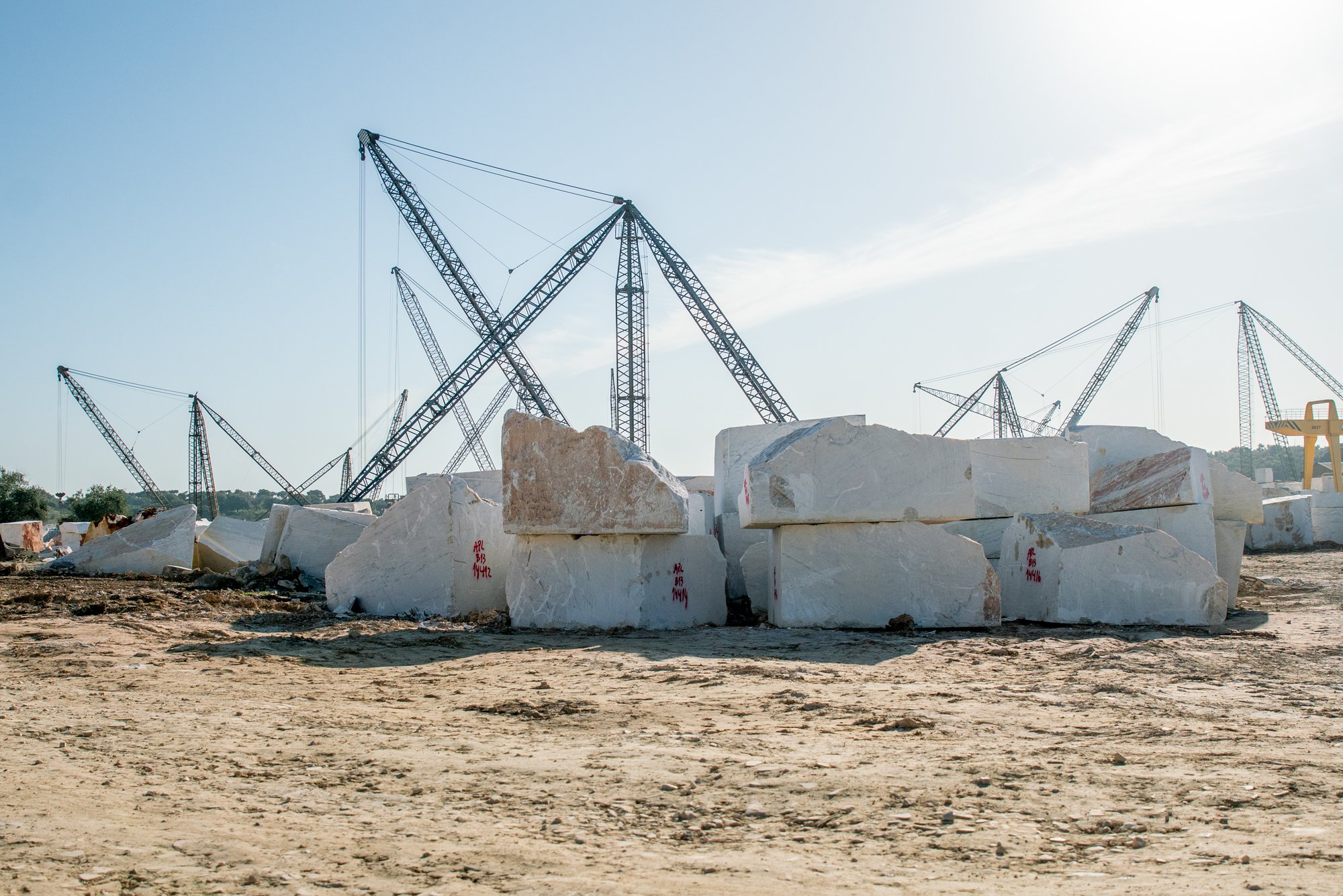
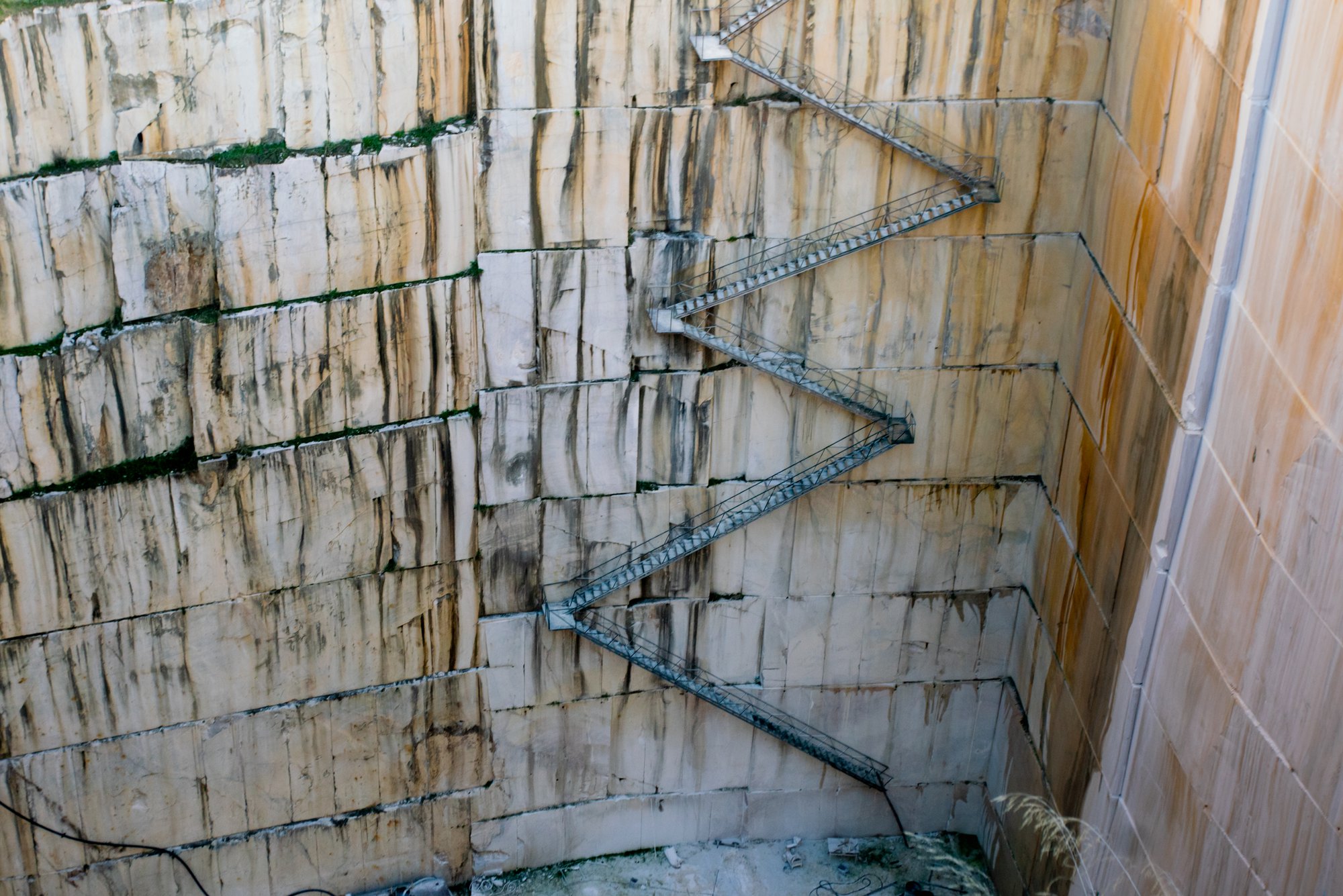
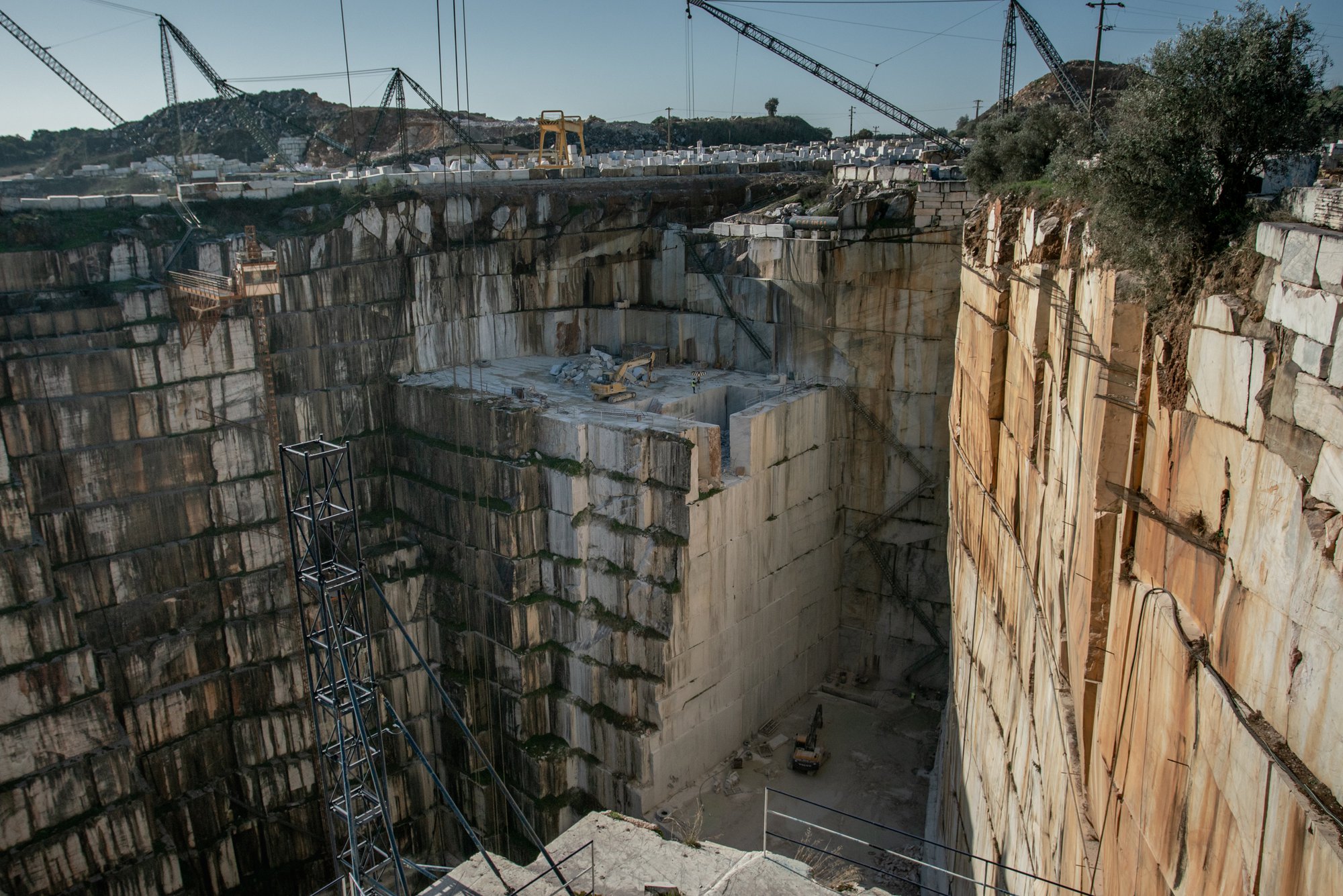
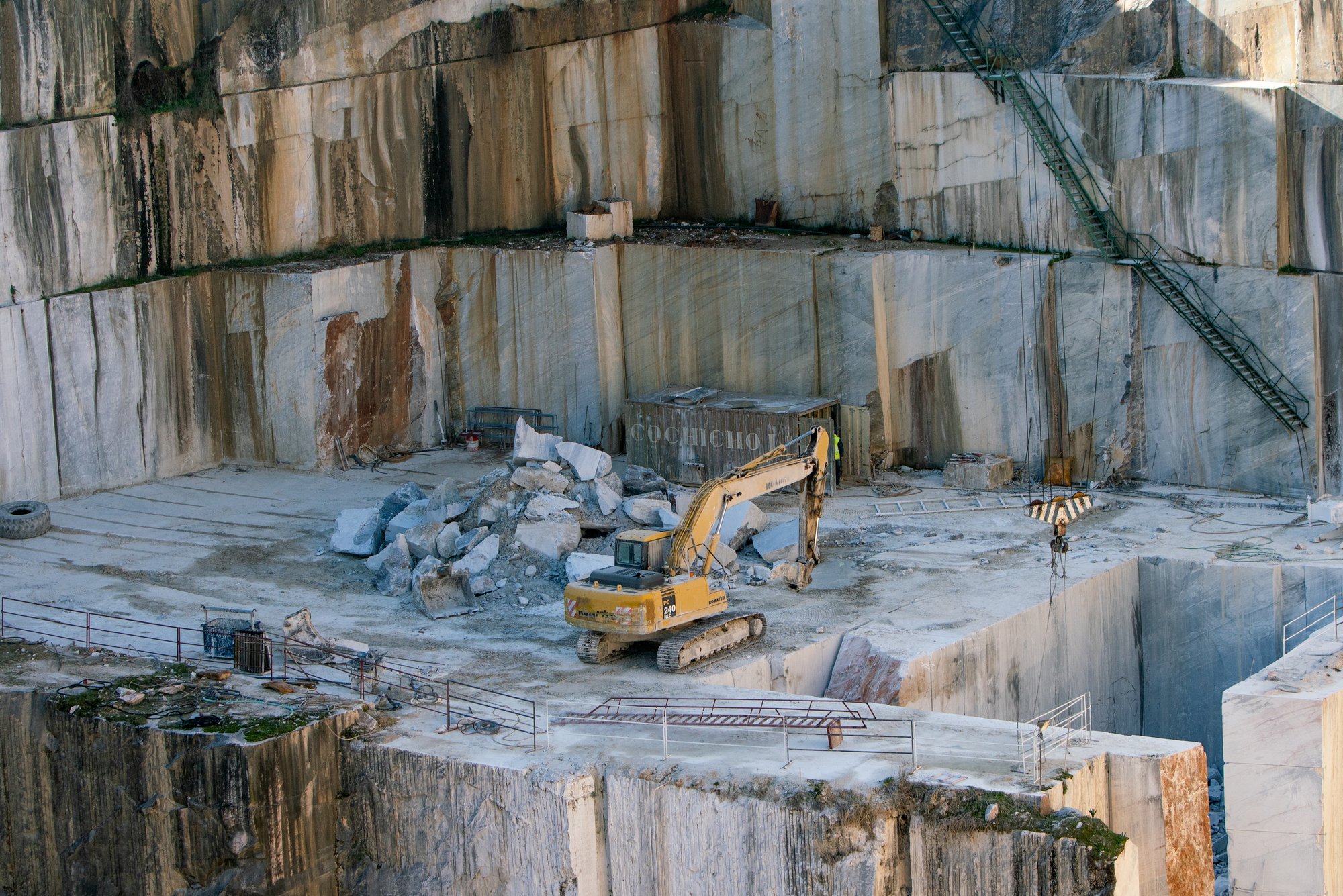
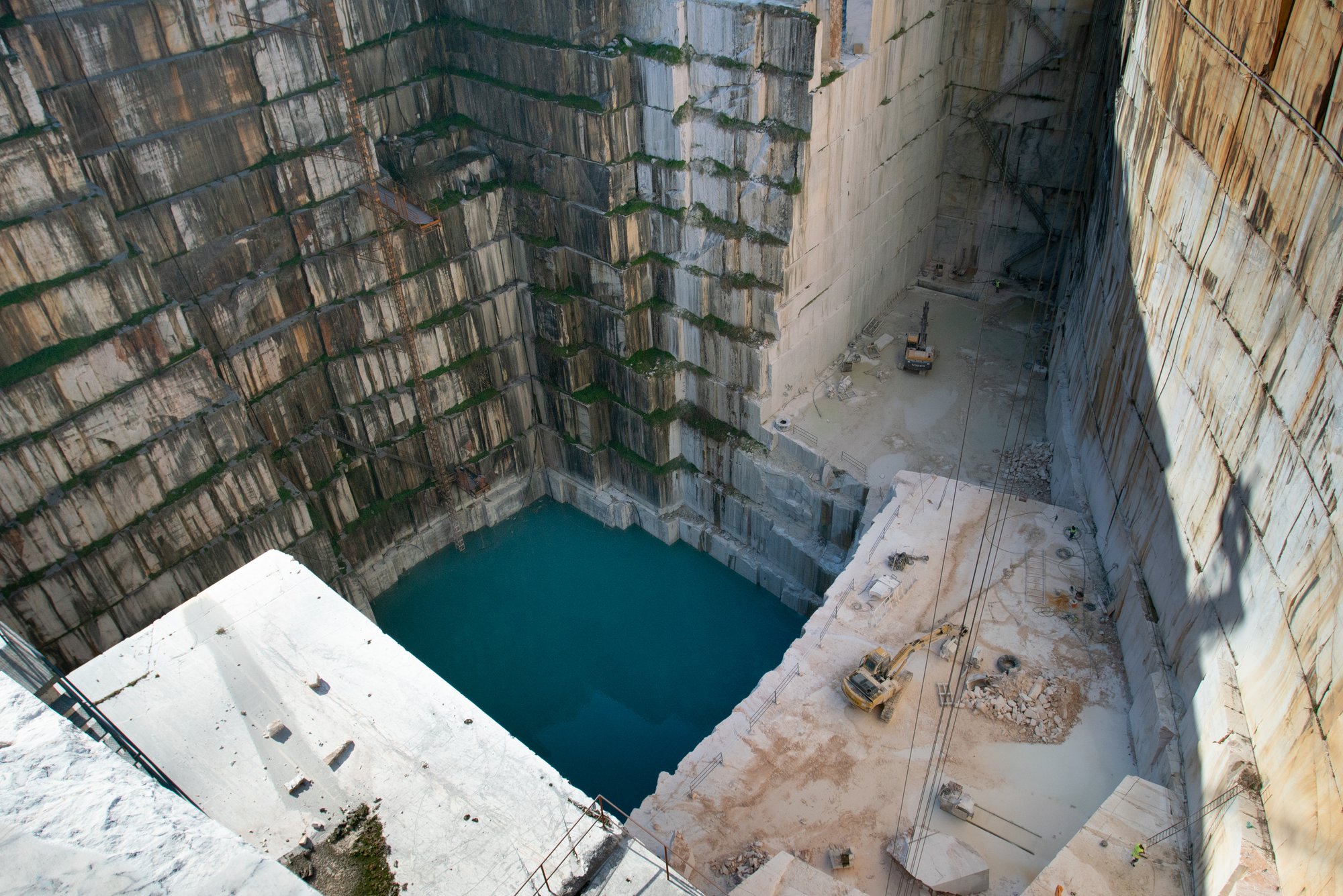
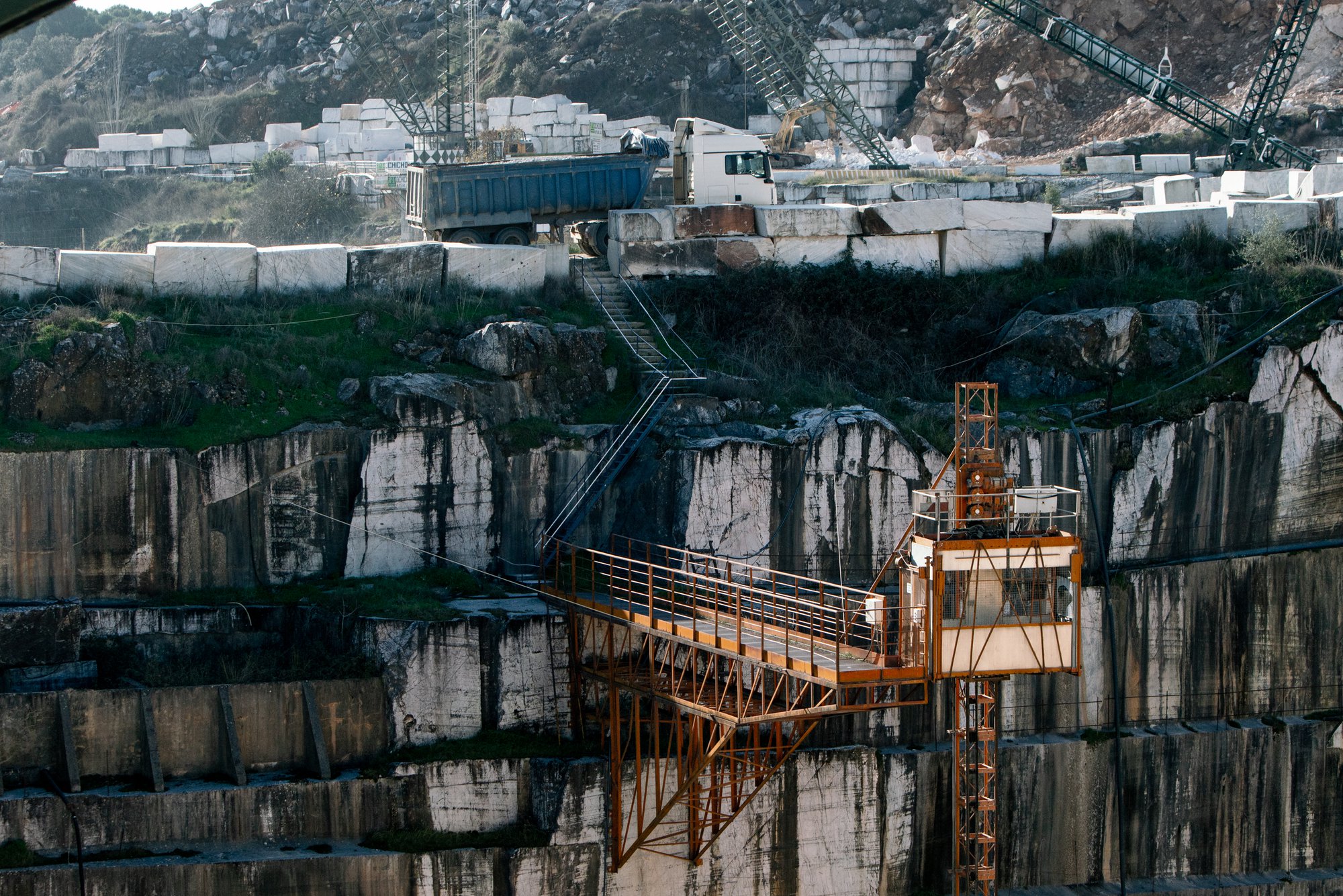
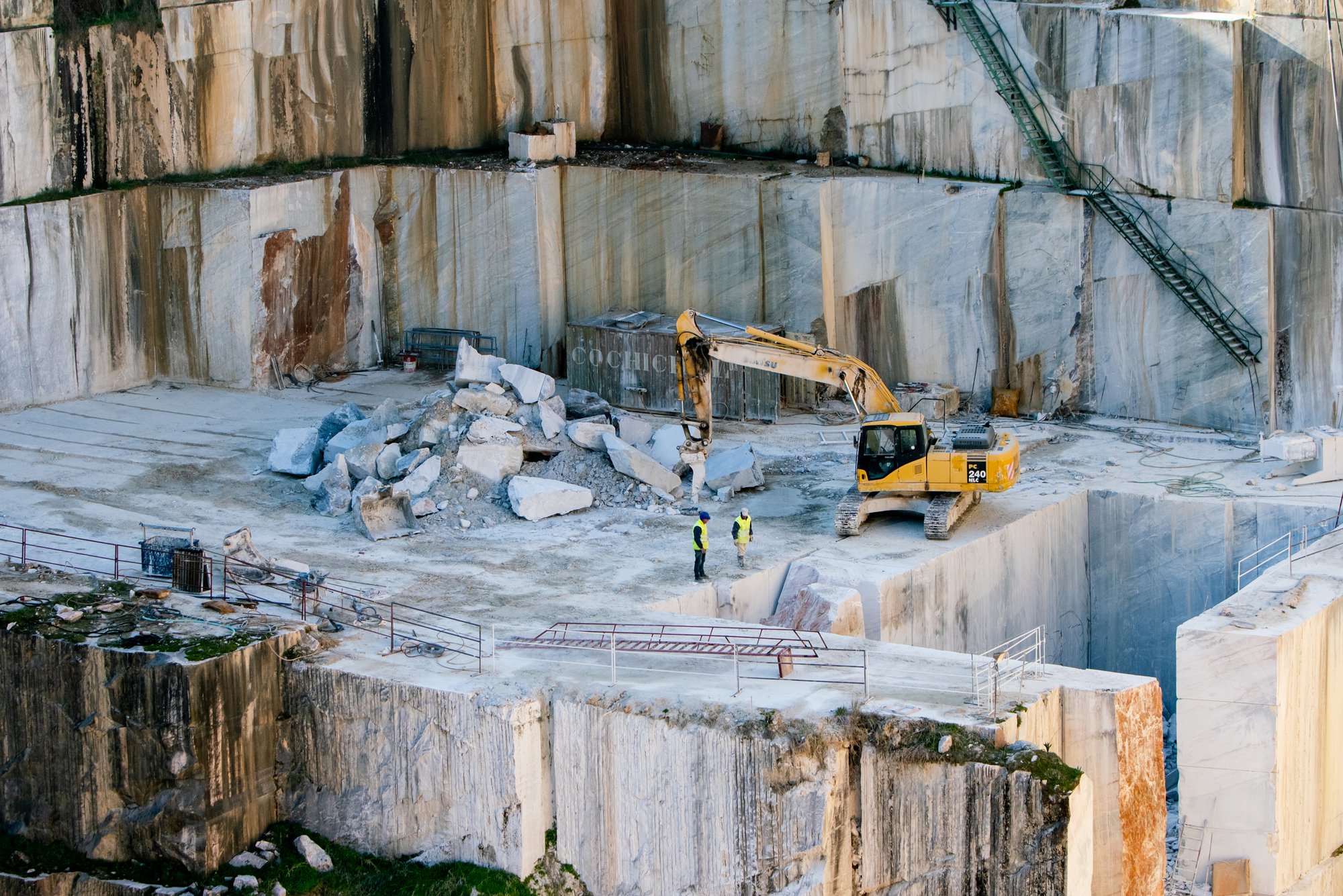
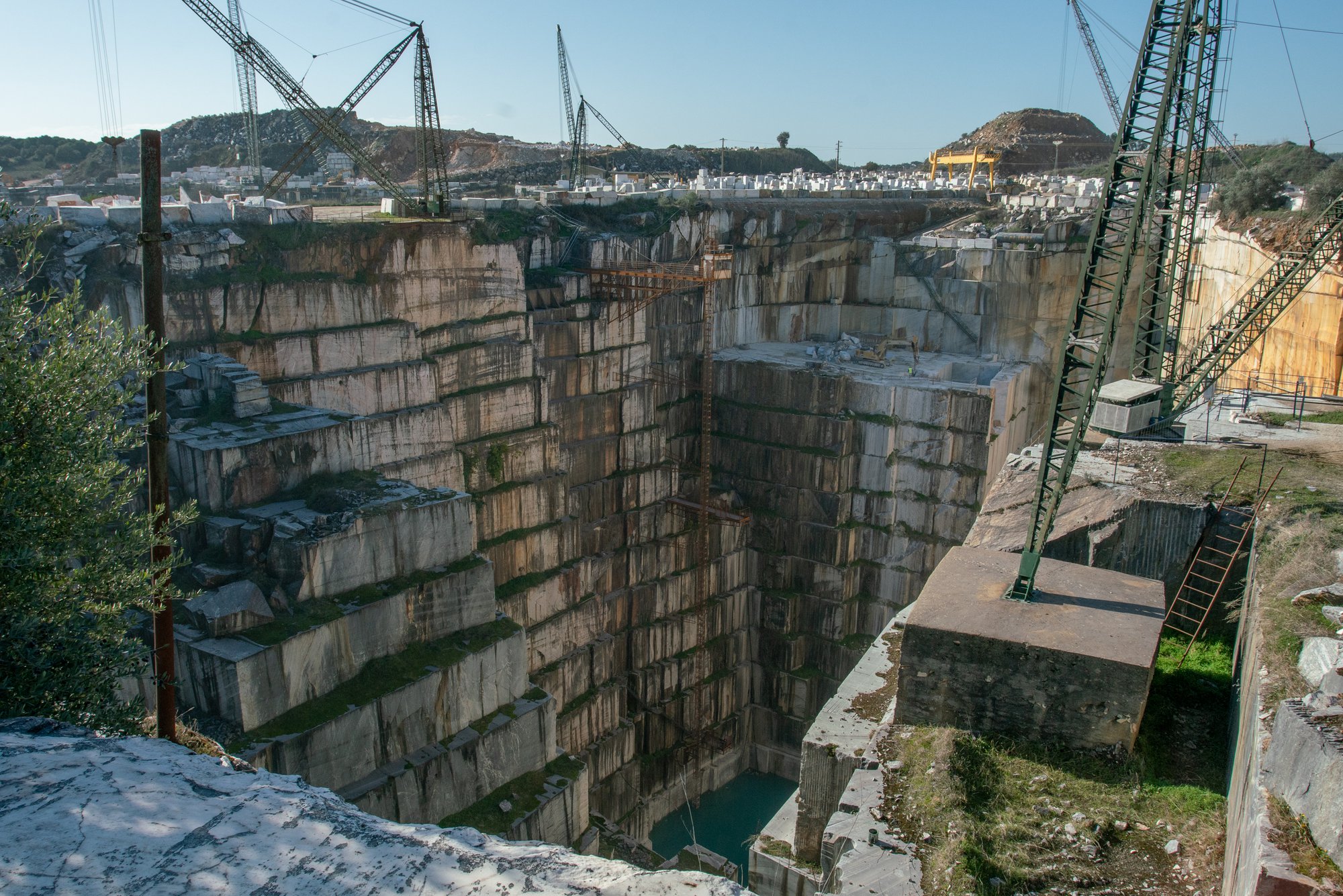
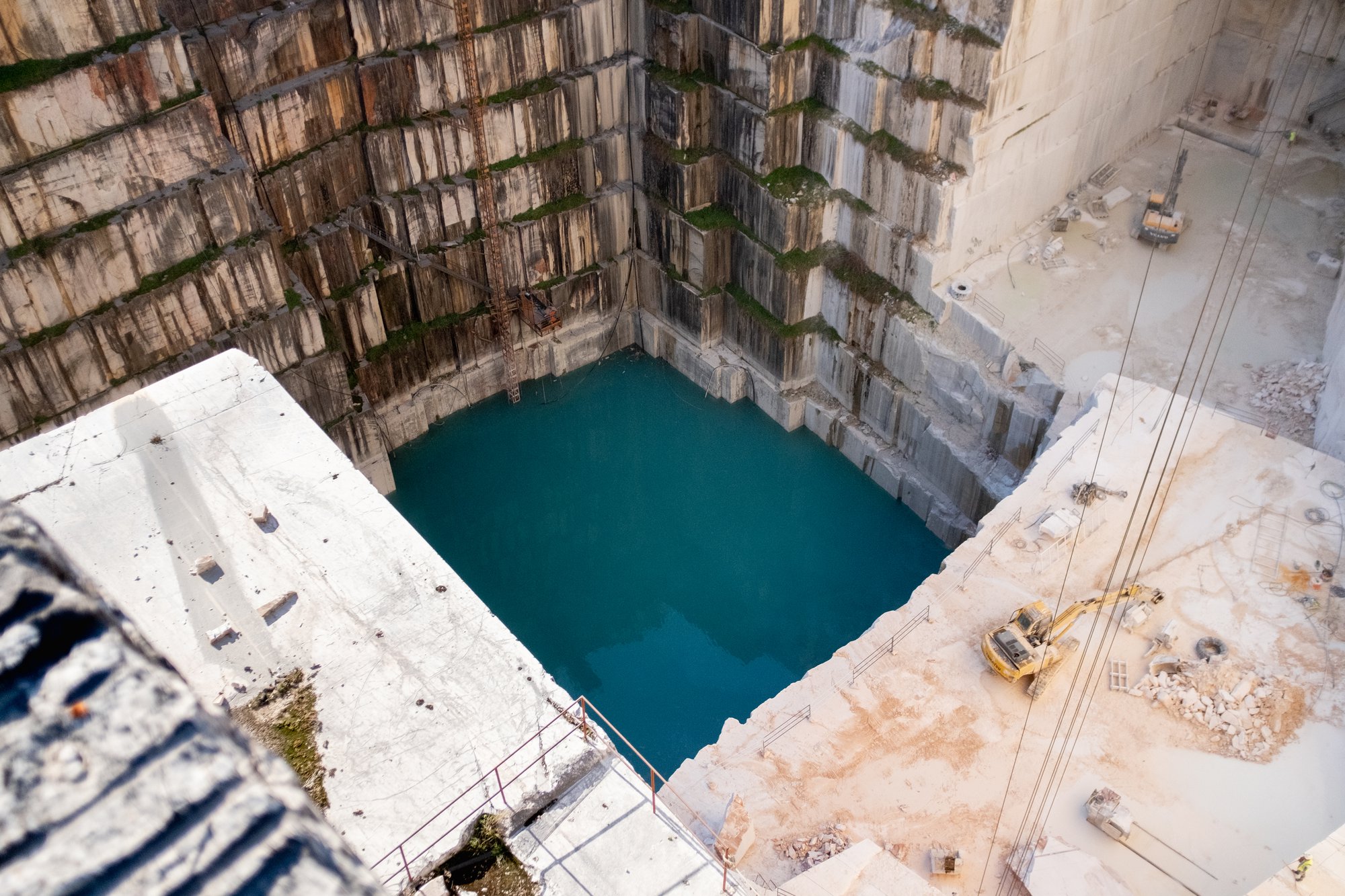
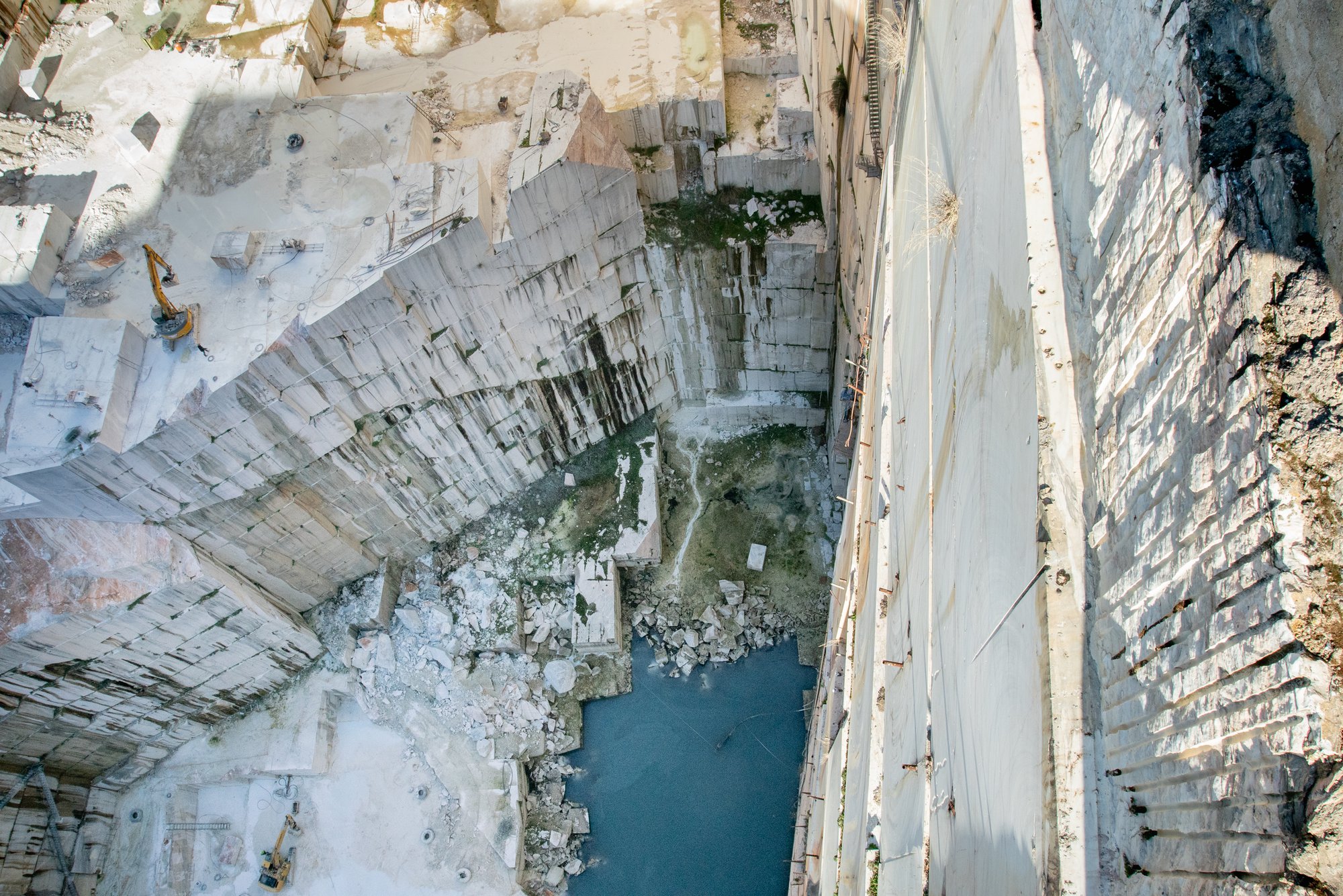
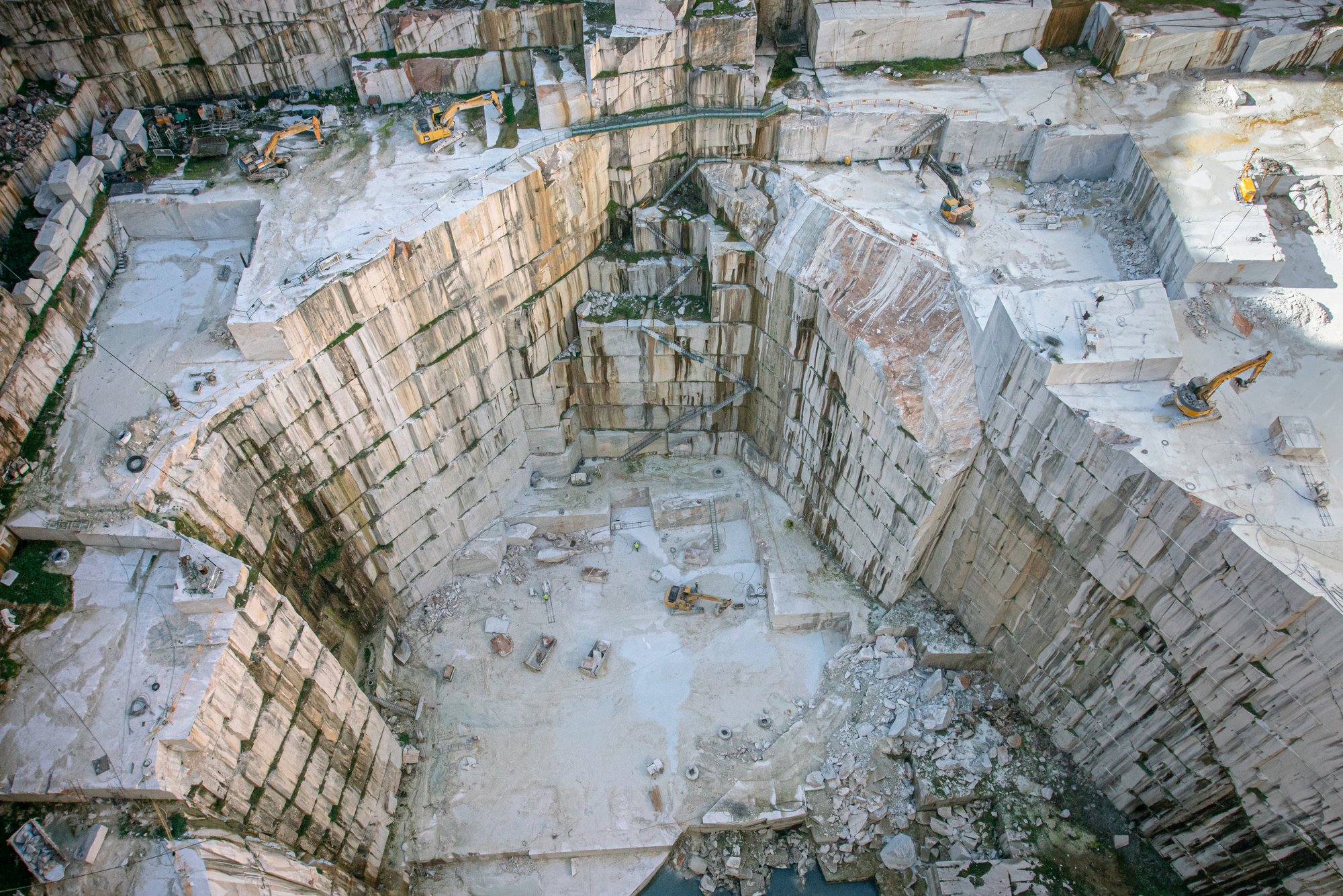
The Nude and the Wood features ten sculptures and two videos distributed symmetrically throughout Culturgest's space. As these works will make clear, symmetry is one of the resources of which this duo makes frequent use. Not just because it is the "golden rule" of decoration or because we find it in the structure of most living things, but because it is the most widespread and acceptable of all repetitions. To repeat, insist, redo, recover, persevere – all are key verbs when encountering these artists' work. So are notions of humour, process, ornament, scatology or cosmogony. Each of these contributes to the constitution of a body of work that materially and conceptually resembles the reverse of science-fiction. Here, the speculative impetus is not invested in the foresight of a dystopian future, but in the discovery of a utopian past in which moral, ideological and aesthetic constraints had not yet emerged, and where humour and playfulness ruled over all bodies.
por Bruno Marchand
+ Keep ReadingPerformativity and experience
The pieces we find here are deeply marked by the impulse towards high performativity that the artists have always nourished. In the irregularity of its grooves and the shaping of its forms we find evidences of intense manual labour. The instruments and techniques used to produce these objects dispensed with all the conveniences and advantages afforded by recent technologies. Instead, the artist took it upon themselves, and their own hands, to shape the pieces from massive blocks of raw material, embarking on an epic and apparently anachronistic method of work. This choice has both ethical and ideological motivations. On the one hand, it is the result of an uncompromising search for productive autonomy, for the ability to (as the artists stated in an interview) to “have control of matter and process, without having to negotiate with a supplier over a poetic world"; on the other, it affirms a relationship to the material world that contradicts – even scorns or ironises – the widespread tendency towards the virtualisation of experience. As we hurtle towards the mediation of all intersubjective relations through algorithms, Dewar and Gicquel explore a relationship to both work and life that is based on the embodiment of experience. The pleasure of making, performing, repeating and learning, with and through the body, is placed at the service of a hyper-awareness of what surrounds us, of the dimensions of our body in the world, of the place we occupy among the greater community of living beings.
Utilitarian and decorative
The pieces presented in this room are dressers, chests and cabinets – utilitarian objects that are fully functional, yet also decorated in a very peculiar way. Using the bas-relief technique, these objects are adorned with plant and animal figures which work to signal a rustic and grotesque world whose bucolic character stands in stark contrast to the aspirations to sophistication and seriousness we often associate with contemporary art. Feet, noses and squashes, snails, wellies, pigs' heads and bowels make up a kind of showcase of the abject – a collection of motifs which are at times unusual, at times repulsive, and which seem to undermine their own status as either ornaments for domestic furniture or as motifs for contemporary sculpture. If we add to these two characteristics the artists' insistence on dispensing with all technological advantages in their production, these works seem to be the result of a calculated escape from all artistic conventions, social expectations and the dictates of economic reason. Not merely sculptures, nor merely furniture; not merely symbolic, nor merely decorative: these works open a radically dubious space at the crossroads of different traditions and uses. They are objects of a comic and ironic muteness. Free of all rhetoric and message, they bring us face to face with the most blunt expressions of the anti-spectacles and the anti-monument.
Relief and relief
Similarly to their woodworks, the duo's marble pieces make use of the sculptural technique of relief. The type of stone used by the artists is of Portuguese origin and its pink tone is particularly important in this context. It not only establishes a set of relationships to the ideas of skin and flesh signalled by the title of the works (Nudes), but also with the utilitarian and decorative uses that this material has traditionally been put to. If the wooden pieces refer us to the context of the bedroom, the kitchen or the living-room, the motifs featured on the marble pieces clearly refer us to the bathroom. Among all the different sections of a house, the bathroom is that which most underlines the scatological dimension of our existence, where we perform the rituals of body cleansing and maintenance. Washing, cutting, cleaning, evacuating are all activities we carry out in this most discreet area of the house. And it is here too that we are reminded that the body is itself a place of process and repetition, but also of affliction, relief and pleasure. What the washbasin, the bidet, the toilet or the body itself have in common is that they are all temporary repositories for the passage of life and its fluids: of sweat, semen, blood, lymph. Nothing really sticks to them; everything passes through. They are objects of the transitory and the vulgar, as well as of pudency, shame and reserve – major emblems of our condition as animals, symbols of the dirty infrastructure running beneath any and all splendour.
Non finito
Non finito is a sculptural technique that consists in retaining part of the raw block of material on which a figure has been carved. Literally meaning "unfinished”, the term may describe sculptures that were abandoned before completion, but it is especially used to denote works which, fully finished, want to lay bare the relationship between the sculpted figure and the block of raw material at its origin.
In the case of the marble works by Dewar and Gicquel, another reading of the non finito effect imposes itself. The relationships established in pieces between human bodies and utilitarian objects, allied to its generalized domestic incline, refer us, almost inevitably, to the universe of archaeology. Seen from that perspective, the figures presented here would not have been sculpted from a block of marble, but discovered embedded in the stone itself, as if they were traces of a historical reality, once buried by the lava of a Vesuvius, kept hidden and preserved in the impenetrable mass of the earth's crust. This reality would have been similar in every way to our own, but only slightly distorted: enlarged, fragmented, duplicated, cracked. In it, art seems not to have existed, only allegorical and utilitarian objects, things that invoke bodies, that suggest uses and behaviours that are also slightly distorted, but much less constrained, censored and bureaucratic. As if these pieces were instances of a place where morals were suspended and where the absurd was not a sign of existential anguish, but precisely its opposite.
Stop motion
Stop motion is an animation technique in which the sensation of movement is created by sequencing photographs that have captured slight changes in the shape or position of inanimate objects. Dewar and Gicquel began experimenting with it in the mid-2000s. Contrary to this technique’s standard practice, Dewar and Gicquel’s modelling was not performed in small-scale figures nor in materials whose flexibility allowed them to make multiple changes with ease. The artists rather chose to use large-scale clay figures, most of which were modelled outdoors. None of the sculptures created in the context of these animations survived beyond the photographs that were made of them. The extraordinary effort invested in the elaboration of these works was condensed in the form of digital projections lasting less than a minute. The questions these animations seem to pose are of two distinct natures. The first concerns the impulse to render visible the movement and interaction that the sculptures themselves already denote. The coexistence of objects, humans and animals in these artists' universe suggests a peculiar community. What these digital animations manifest, in the end, is a simulation of the life of this community in small episodes. It is, in a way, a meta-production, a speculation which begins from concrete material evidence, like a 3D rendition of an unwitnessed event, but using fully analogue technology. This leads us to the second question and to that which was mentioned before regarding the issues of performativity and the embodiment of experience, which seem here to be taken to the point of paroxysm. The labour involved in the construction of these brief animations implodes the logics which underpin the very idea of work, sustained as it is by a balance between intention and effect. By allocating to intention the overwhelming majority of the weight of these works, the artists subvert the capitalist order of things, operating like Quixote before his giant windmills, assured of the symbolic, ethical and ideological victory of their charge.
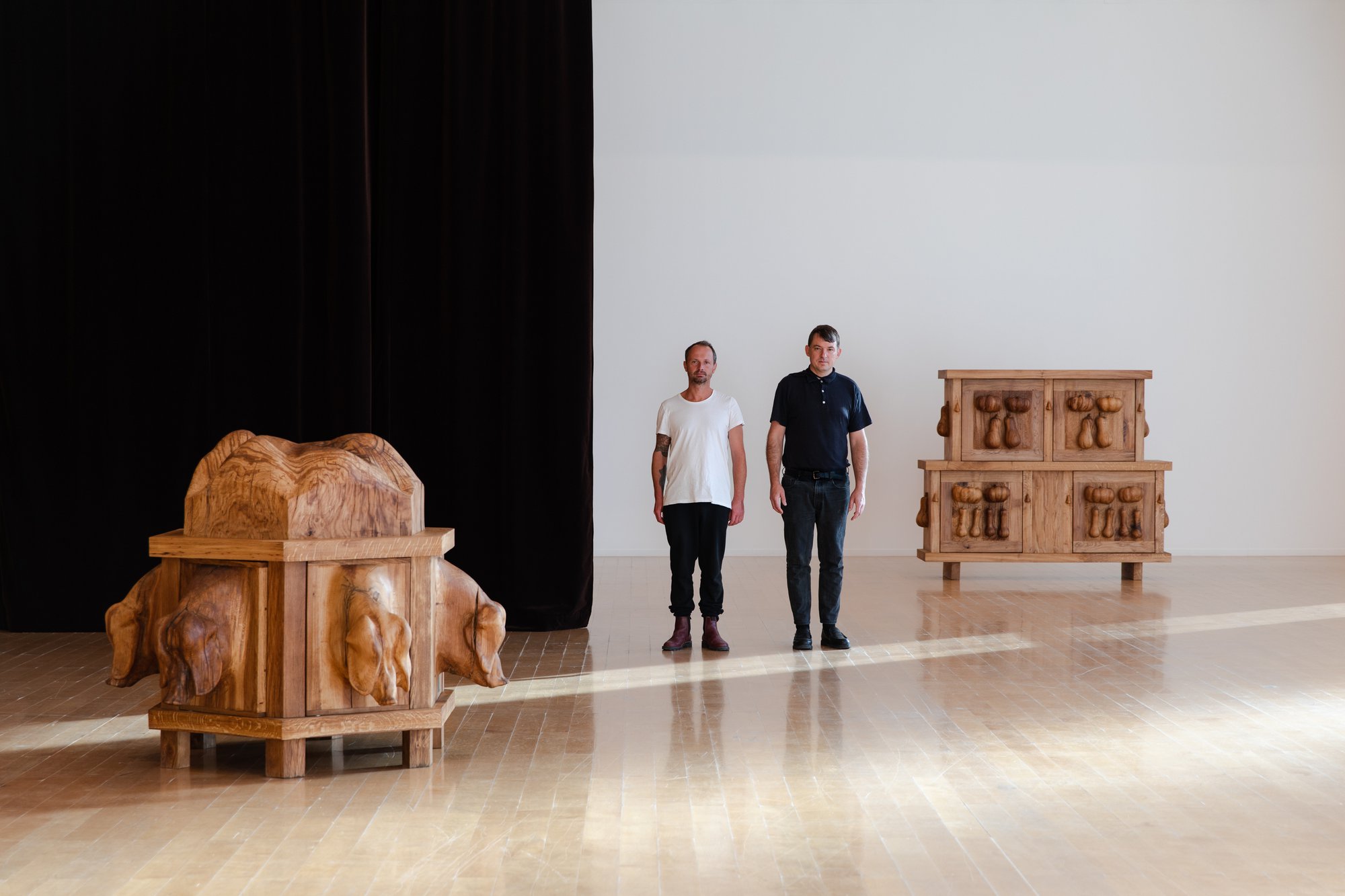
Daniel Dewar & Grégory Gicquel met at the Rennes School of Fine Arts, in France, in 1997, the year in which they began their artistic collaboration. Their trajectory began with a public, unannounced staging of long-term performances (eight working hours) during which the artists replicated, again and again, seemingly simple gestures or actions, such as dribbling a ball or eating an ice-cream. After about two years devoted to creating this kind of performance, they founded two projects that fit in perfectly with the commercial fabric of Rennes: the 2000 Voyages travel agency and the Alma Skateshop. The former replaced dream travel destinations and modes of transport with much more banal propositions, such as bus rides to the University, lifts to the nearest petrol station, or jogging sessions in the city park. The latter provided the public with everything they might need to practice skateboarding – skateboards, wheels, trucks, jeans, white t-shirts, trainers –, and every product, as well as the tools used to make it, were made by hand by the artists themselves.
+ Keep ReadingIn the mid-2000s, and following these early experiences, notions of commitment and mission, combined with an obsession for achieving productive autonomy and independence from any kind of third-party service providers, made this duo embark on an epic journey to recover traditional sculpting craftsmanship, such as working with terracotta, metal, wood, stone or textiles. Since then, their pieces have served to build a unique world – a world similar to ours in every way, only slightly distorted: augmented, fragmented, duplicated, merged, failed, amalgamated, metamorphized. As if the objects they make belonged to a parallel universe where the absurd is not a sign of existential angst, but rather its opposite.
Their work has been shown in solo exhibitions at renowned institutions such as Secession (Vienna, AT), Van Buuren Museum & Gardens (Brussels, BE), Kunsthalle Basel (Basel, CH), Musée d’Art Contemporain (Lyon, FR), Portikus (Frankfurt, DE), HAB Galerie (Nantes, FR), Witt de With Center for Contemporary Art (Rotterdam, NL), KIOSK (Gante, FR), Front Desk Apparatus (New York, USA), Musée Rodin (Paris, FR), Centre Pompidou (Paris, FR), Palais de Tokyo (Paris, FR), or Spike Island (Bristol, UK).
In 2012, they were awarded the Marcel Duchamp Prize, an international prize granted annually by the Association pour la Diffusion Internationale de l'Art Français (ADIAF).
Their work has been the object of several monographs, which can be found at the Culturgest bookshop:
Daniel Dewar & Grégory Gicquel: Sculptures in the Round (Vienna: Secession, 2021).
Daniel Dewar & Grégory Gicquel: Body of Work (London: Koenig Books, 2019).
Daniel Dewar & Grégory Gicquel: Rosa Aurora (Nantes: Le Voyage à Nantes; Brussels: Triangle Books, 2017).
Daniel Dewar & Grégory Gicquel: Le Hall (Paris: Centre Pompidou, 2013).
Daniel Dewar & Grégory Gicquel: Crêpe Suzette (Paris: Editions Loevenbruck, 2012).
Daniel Dewar & Grégory Gicquel: Mason Massacre (Paris: Éditions Loevenbruck, 2009).
Daniel Dewar was born in 1976, in the Forest of Dean (UK), and he currently lives in Brussels.
Grégory Gicquel was born in 1975, in Saint-Brieuc (France), and he currently lives in Plévenon.
FICHA TÉCNICA
EXPOSIÇÃO
CURADORIA
Bruno Marchand
DIREÇÃO DE PRODUÇÃO
Mário Valente
PRODUÇÃO
Sílvia Gomes
Fernando Teixeira
MONTAGEM
Michael Bennett
Pedro Palma
Xavier Ovídio
António Cavaco e Vitor Anceriz (Feirexpo)
AGRADECIMENTOS
C L E A R I N G, Brussels
Jan Kaps, Cologne
Loevenbruck, Paris
IMAGENS DAS PEDREIRAS
Pedro Jafuno
EDIÇÃO
Inês Bernardo
REVISÃO CONTEÚDOS
Catarina Medina
TRADUÇÃO
Rita Matos
